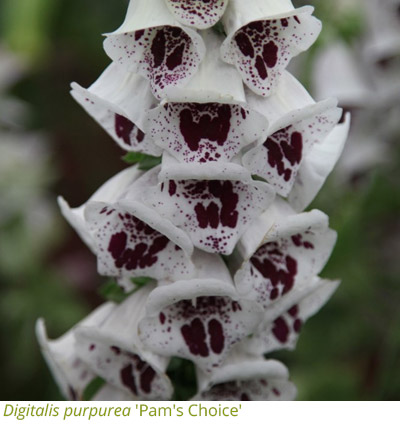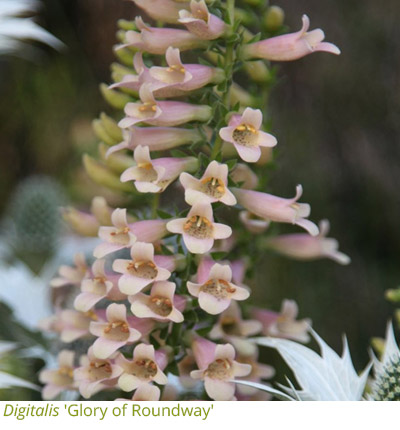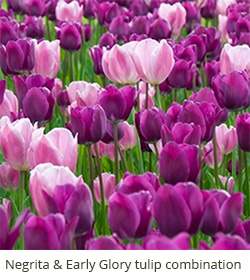If you want to plant a really bee-friendly plant, plant a foxglove because this provides a stick of flower that lasts for 3 to 4 weeks. The flowers open from the bottom upwards and they are often spotted and dappled because bees use infrared light. Spots and veins show up really strongly and lure the bee into the flower. Most foxgloves set copious amounts of seed, sometimes too many. That’s because when the bee arrives in search of nectar the lower flowers have lots of pollen, but no nectar, so the bee is forced to go to the next flower up in search of nectar. The pollen from the lowest flowers gets distributed right up the spike and this allows maximum seed set.
 Foxgloves are not woodlanders, as is often said. They spring up in woodland clearings when the seeds are exposed to the light. This type of plant is called a disturbance plant, because the seeds must be in a light bright position before they germinate. This has implications when sowing seed, because the seeds mustn't be covered in a thick layer of compost. Foxgloves are not woodlanders, as is often said. They spring up in woodland clearings when the seeds are exposed to the light. This type of plant is called a disturbance plant, because the seeds must be in a light bright position before they germinate. This has implications when sowing seed, because the seeds mustn't be covered in a thick layer of compost.
The most commonly grown foxglove is a British native called Digitalis purpurea. This is a biennial and seed sown in the spring will produce a rosette in the first year and this overwinters, so foxgloves often provide good winter foliage. In the second year a flower spike emerges and flowers and then the plant sets seed and dies. Many of the most widely grown forms are pink, but there are also whites, apricots and yellow. Some are heavily spotted in magenta, others have completely plain flowers. Experience has taught me that if you want to plant a biennial so that it appears year after year you have to plant in three consecutive years, so that you get a rosette followed by a flowering spike followed by a gap. They will grow in dappled shade and the white and apricot forms can light up a dank area. However foxgloves will only self seed in bright positions, so plants will have to be added to fill the inevitable gaps. Plants bought in spring will usually flower this summer.
Foxgloves are easy to grow from seed, but at this time of year you would be better to start with a flowering plant so that you get flowers in midsummer. There's a lot of folklore about foxgloves, probably because they flower close to the summer solstice. The shape of the flower is said to resemble a Druid’s hood and there are lots of common names associated with fairies such as goblin’s gloves and fairy music. The name foxglove is said to be Scandinavian, and it refers to a musical instrument that's a stick of bells rather like that brandished by Morris dancers.
 Our native plant, Digitalis purpurea is also a medicinal plant and it was a gypsy remedy for a deadly disease called dropsy. A Shropshire doctor called William Withering was given the remedy and made a fortune in the later years of the 18th century. Digitalis is still used medicinally today, in very small amounts, because this is a toxic plant. The great advantage to the gardener is that the grey-green foliage is shunned by deer and rabbits so this might be useful if they are a problem in your garden. Our native plant, Digitalis purpurea is also a medicinal plant and it was a gypsy remedy for a deadly disease called dropsy. A Shropshire doctor called William Withering was given the remedy and made a fortune in the later years of the 18th century. Digitalis is still used medicinally today, in very small amounts, because this is a toxic plant. The great advantage to the gardener is that the grey-green foliage is shunned by deer and rabbits so this might be useful if they are a problem in your garden.
There are selected seed strains of Digitalis purpurea and these include a relatively new one called ‘Pam's Choice’. It’s a beauty with white flowers that are heavily marked in maroon. One of the best ways to use biennial foxgloves is among old fashioned roses, as their maroon markings will pick up the colour of all dark pink and almost purple roses - or you could use bright pink foxgloves with pale pink roses. The two go together really well.
The flowers of ‘Pam's Choice’ are quite wide, but the ‘Excelsior Group’ have tall spikes of slender flowers so they are very elegant. Seeds and plants are available. New breeding has produced foxgloves that flower in their first year and the Dalmatian series is one of these. The flowers are outward facing and the spikes are shorter, roughly two feet high, but ‘Dalmatian Purple’ is a very colourful plant at the front of the border. There is also a ‘Dalmatian White’, ‘Dalmatian Rose’ and a ‘Dalmatian Peach’.
If you're planning to grow foxgloves in semi-shade, the unspotted whites and pale apricots look really handsome, especially when planted close to blues. ‘Sutton’s Apricot’ and the pure white Digitalis purpurea f. albiflora are far better in shade because bright sunshine washes out the colour.
 Not all foxgloves are biennial. Many other European species are long lived perennials and these can be very useful in the garden. The pale yellow Digitalis lutea is tall and slender with small pallid lemon flowers tightly arranged on a spire. This will grow in deep shade and persist for many years and it will also self-seed. It’s a useful plant and I grow it in a wild area close to honeysuckle (Lonicera periclymenum) along with blue comfrey. There is another pallid yellow foxglove called Digitalis grandiflora, although I haven't found this is long lived. The soft foliage feels almost felty to the touch and the lemon flowers, borne on a short spire, have very wide mouths. This needs good drainage, but it's a really useful foxglove because it flowers in May. It’s an excellent plant used with the deep pink Geranium macrorrhizum ‘Bevan’s Variety’. The hybrid Digitalis x mertonensis shares the same soft foliage, but the flowers are a strawberry pink. Although not as long lived as many, the combination of grey green foliage and muted pink flowers is irresistible in May. Not all foxgloves are biennial. Many other European species are long lived perennials and these can be very useful in the garden. The pale yellow Digitalis lutea is tall and slender with small pallid lemon flowers tightly arranged on a spire. This will grow in deep shade and persist for many years and it will also self-seed. It’s a useful plant and I grow it in a wild area close to honeysuckle (Lonicera periclymenum) along with blue comfrey. There is another pallid yellow foxglove called Digitalis grandiflora, although I haven't found this is long lived. The soft foliage feels almost felty to the touch and the lemon flowers, borne on a short spire, have very wide mouths. This needs good drainage, but it's a really useful foxglove because it flowers in May. It’s an excellent plant used with the deep pink Geranium macrorrhizum ‘Bevan’s Variety’. The hybrid Digitalis x mertonensis shares the same soft foliage, but the flowers are a strawberry pink. Although not as long lived as many, the combination of grey green foliage and muted pink flowers is irresistible in May.
There are also early summer flowering foxgloves that are perennial and many have tapering spires of much smaller flowers. Digitalis parviflora, known as the small flowered foxglove, comes from the Mediterranean area so it needs good drainage and a warm site to flower well. The foliage is ribbed, almost like a plantain, and the flowers are chocolatey. This plant is loved by garden designers. They are very slender plants so you need to plant a group of at least five, about a foot apart, to make an impact in the garden. As the flowers fade, they'll make a good autumn and winter silhouette so they are often used in prairie planting with asters, heleniums and grasses. Digitalis parviflora does set seed and it is long lived.
 There are also sterile hybrids that flower on and on, because they are unable to be pollinated and therefore cannot set seed. ‘Glory of Roundway’, a seedling discovered in a Wiltshire garden, has a combination of rhubarb-pink and custard coloured flowers. Another hybrid, ‘Spice Island’, has flowers with an extended bottom lip and these look as though they've been dusted in cinnamon. There are also sterile hybrids that flower on and on, because they are unable to be pollinated and therefore cannot set seed. ‘Glory of Roundway’, a seedling discovered in a Wiltshire garden, has a combination of rhubarb-pink and custard coloured flowers. Another hybrid, ‘Spice Island’, has flowers with an extended bottom lip and these look as though they've been dusted in cinnamon.
One of the reasons that these bee-friendly plants are so useful in the garden is that they provide a vertical presence. So many plants make roundels so it's important to provide an upright presence to break up the monotony. The bees will love you and your garden will be full of flower when the days are at their longest.
|













